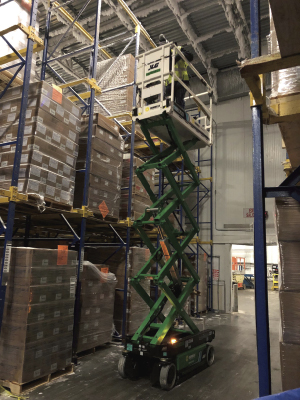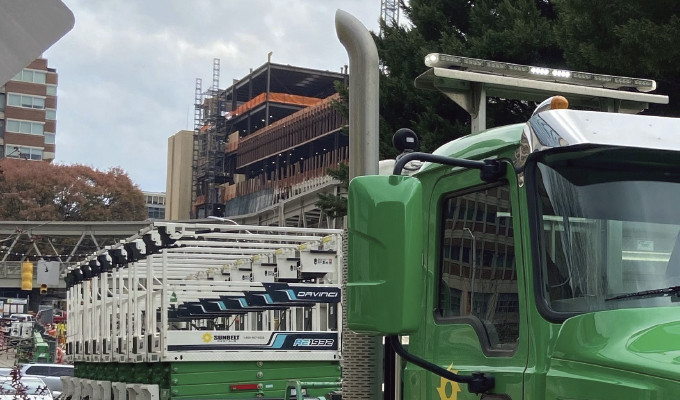Many remember the challenges they had operating early generations of electric hand drills or other battery-powered tools—the batteries would drain quickly, or these tools would perform poorly, when temps dip below freezing.
These experiences left a lasting impression, even after several generations of battery technology later. Today, people are still hesitant to use electric equipment in cold-temperature applications like refrigerated food processing warehouses, cold-storage facilities, vaccine laboratories, or outdoors in winter weather conditions, to name a few.
“Working in below-freezing temperatures can impact the performance of equipment, resulting in slow, sluggish functionality, as well as reduced battery runtime by up to 50%, in part due to hydraulics and previous battery technology,” says Bob Begley, JLG’s director of product management for scissor lifts.
THE NEED FOR ELECTRIC
Despite concerns, electric scissor lifts are often needed on maintenance projects or construction job sites in colder temperatures because of restrictions in certain work environments, like noise and air pollution requirements, that prevent the use of internal combustion (diesel, dual fuel, or gas) machines.
“One of the most important considerations when selecting battery-powered MEWPs for working in cold conditions is productivity,” says Austin Caskey, a product line manager at Sunbelt Rentals. “Our customers want to rent electric scissor lifts that are dependable and ready to work. But at any given time in a below-freezing work area, due to rapidly declining performance, you may need twice the number of scissor lifts that you’d usually need to get the job done.”
Begley says that it’s commonplace for a hydraulic scissor lift equipped with flood-leaded acid (FLA) batteries to not even get a full shift’s worth of work in freezing temperatures. He also notes that it takes at least eight hours to fully charge these machines.
But, what about the JLG® AE1932 DaVinci® lift with its all-electric components and quick-charging lithium-ion battery pack?
“We had a lot of assumptions about how the DaVinci lift would perform in below-freezing conditions that we needed to put to the test,” says Begley.

FREEZER APPLICATION TEST
To find out, JLG and Sunbelt Rentals teamed up to test the performance of the DaVinci scissor lift in an industrial freezer that reaches temperatures as low as 0°F (-18°C). “We chose to run the test in one of the harshest environments we could find,” says Caskey. “Scissor lifts are often used in freezers to complete cleaning and maintenance tasks.”
To start the test, Caskey says that the team placed the DaVinci scissor lift in the freezer with a full charge (97% State of Charge, or SoC) and stored it there overnight.
“We have a lot of customers in the northern U.S. and in Canada that have to store their equipment outside,” he says. “We wanted to simulate the machine being in that kind of environment because they need electric equipment that will work well in lower temperatures.”
Begley says that the following day the team, once the machine was warmed up, began a series of duty-cycle tests (which include drive, elevate, descend, and return cycles) on the DaVinci machine in one of the rows between the freezer’s racks.
SERIES OF FULL TESTS
According to Begley, the DaVinci performed a series of full test cycles in approximately two hours and showed no signs of performance degradation.
“Based on our experiences with hydraulic machines in colder temperatures,” says Caskey, “we expected a loss of performance as we went through the cycles. That’s why we typically rent two scissor lifts at a time for freezer applications, so our customers can alternate machines every couple of hours to ensure their project stays on time (one machine works while the other one warms up and charges).
“With these typical electric scissor lifts,” he goes on, “operators notice a slow decline in performance almost instantly, nearly as soon as a machine starts working.
“But,” he continues, “in the hours we were cycle testing the DaVinci, it never lost functionality or speed in the freezer. We went up and down a lot with the machine during the tests—doing way more than a normal work cycle, and there was no degradation in performance.”
He adds, “That’s a very different response than we would have gotten from a traditional electric-drive model. This capability will translate to huge savings for our customers, both in time (swapping out machines) and money (rental rates), because now they will only have to run one machine to complete the work.”
After cycling power at the end of the test, the battery went from 0% to 2% SoC, allowing the team to move the DaVinci lift to an area where it could be charged. The machine’s internal battery temperature was 51°F (10°C), so the battery could be charged immediately.
Begley notes that JLG has implemented provisions into the DaVinci lift’s proprietary software to protect the battery when the SoC is very low, reducing the risk of damage caused by fully discharging a battery.
CONCLUSION FROM TESTING
Based on a detailed review of the JLG and Sunbelt Rentals test report, Begley says, “We are confident that this machine is suitable for working in cold-environment applications.”
“The 19-ft scissor lift is one of the most commoditized rental machines in the world,” says Caskey. “But this one is unlike anything else available in the market—it charges faster and stays charged longer, and the difference is noticeable.”
CLOSING THOUGHT
He concludes, “Because the DaVinci is engineered with no hydraulics, there is no risk of leaks or spills. This means that we can rent these machines into clean, sensitive environments without our customers being concerned about how the lifts will impact the jobsite. This offers a new solution for our customers in certain facilities to rent this machine to use during planned shutdowns. It’s a big deal.”
About the Author:
Sara Vincent is the director of marketing with JLG. For more, visit jlg.com.
Modern Contractor Solutions, August 2023
Did you enjoy this article?
Subscribe to the FREE Digital Edition of Modern Contractor Solutions magazine.



